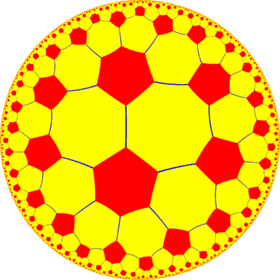| Truncated order-6 square tiling | |
|---|---|
 Poincaré disk model of the hyperbolic plane | |
| Type | Hyperbolic uniform tiling |
| Vertex configuration | 8.8.6 |
| Schläfli symbol | t{4,6} |
| Wythoff symbol | 2 6 | 4 |
| Coxeter diagram | |
| Symmetry group | , (*642) , (*334) |
| Dual | Order-4 hexakis hexagonal tiling |
| Properties | Vertex-transitive |
In geometry, the truncated order-6 square tiling is a uniform tiling of the hyperbolic plane. It has Schläfli symbol of t{4,6}.
Uniform colorings
 The half symmetry = can be shown with alternating two colors of octagons, with as Coxeter diagram |
Symmetry

The dual tiling represents the fundamental domains of the *443 orbifold symmetry. There are two reflective subgroup kaleidoscopic constructed from by removing one or two of three mirrors. In these images fundamental domains are alternately colored black and cyan, and mirrors exist on the boundaries between colors.
A larger subgroup is constructed , index 6, as (3*22) with gyration points removed, becomes (*222222).
The symmetry can be doubled as 642 symmetry by adding a mirror bisecting the fundamental domain.
| Small index subgroups of (*443) | |||||||||||
|---|---|---|---|---|---|---|---|---|---|---|---|
| Index | 1 | 2 | 6 | ||||||||
| Diagram | 
|

|

|

| |||||||
| Coxeter (orbifold) |
= (*443) |
= (*3232) |
= (3*22) |
= (*222222) | |||||||
| Direct subgroups | |||||||||||
| Index | 2 | 4 | 12 | ||||||||
| Diagram | 
|

|

| ||||||||
| Coxeter (orbifold) |
= (443) |
= (3232) |
= (222222) | ||||||||
Related polyhedra and tilings
From a Wythoff construction there are eight hyperbolic uniform tilings that can be based from the regular order-4 hexagonal tiling.
Drawing the tiles colored as red on the original faces, yellow at the original vertices, and blue along the original edges, there are 8 forms.
| Uniform tetrahexagonal tilings | |||||||||||
|---|---|---|---|---|---|---|---|---|---|---|---|
| Symmetry: , (*642) (with (*662), (*443) , (*3222) index 2 subsymmetries) (And (*3232) index 4 subsymmetry) | |||||||||||
= = = |
= |
= = = |
= |
= = = |
= |
||||||

|

|

|

|

|

|

| |||||
| {6,4} | t{6,4} | r{6,4} | t{4,6} | {4,6} | rr{6,4} | tr{6,4} | |||||
| Uniform duals | |||||||||||

|

|

|

|

|

|

| |||||
| V6 | V4.12.12 | V(4.6) | V6.8.8 | V4 | V4.4.4.6 | V4.8.12 | |||||
| Alternations | |||||||||||
(*443) |
(6*2) |
(*3222) |
(4*3) |
(*662) |
(2*32) |
(642) | |||||
= |
= |
= |
= |
= |
= |
||||||

|

|

|

|

|

|

| |||||
| h{6,4} | s{6,4} | hr{6,4} | s{4,6} | h{4,6} | hrr{6,4} | sr{6,4} | |||||
It can also be generated from the (4 4 3) hyperbolic tilings:
| Uniform (4,4,3) tilings | ||||||||||
|---|---|---|---|---|---|---|---|---|---|---|
| Symmetry: (*443) | (443) |
(3*22) |
(*3232) | |||||||

|

|

|

|

|

|

|

|

|

|

|
| h{6,4} t0(4,4,3) |
h2{6,4} t0,1(4,4,3) |
{4,6}/2 t1(4,4,3) |
h2{6,4} t1,2(4,4,3) |
h{6,4} t2(4,4,3) |
r{6,4}/2 t0,2(4,4,3) |
t{4,6}/2 t0,1,2(4,4,3) |
s{4,6}/2 s(4,4,3) |
hr{4,6}/2 hr(4,3,4) |
h{4,6}/2 h(4,3,4) |
q{4,6} h1(4,3,4) |
| Uniform duals | ||||||||||

|

|

|

|
|||||||
| V(3.4) | V3.8.4.8 | V(4.4) | V3.8.4.8 | V(3.4) | V4.6.4.6 | V6.8.8 | V3.3.3.4.3.4 | V(4.4.3) | V6 | V4.3.4.6.6 |
| *n42 symmetry mutation of truncated tilings: n.8.8 | |||||||||||
|---|---|---|---|---|---|---|---|---|---|---|---|
| Symmetry *n42 |
Spherical | Euclidean | Compact hyperbolic | Paracompact | |||||||
| *242 |
*342 |
*442 |
*542 |
*642 |
*742 |
*842 ... |
*∞42 | ||||
| Truncated figures |

|

|

|

|

|

|

|

| |||
| Config. | 2.8.8 | 3.8.8 | 4.8.8 | 5.8.8 | 6.8.8 | 7.8.8 | 8.8.8 | ∞.8.8 | |||
| n-kis figures |

|

|

|

|

|

|

|

| |||
| Config. | V2.8.8 | V3.8.8 | V4.8.8 | V5.8.8 | V6.8.8 | V7.8.8 | V8.8.8 | V∞.8.8 | |||
| *n32 symmetry mutation of omnitruncated tilings: 6.8.2n | ||||||||||||
|---|---|---|---|---|---|---|---|---|---|---|---|---|
| Sym. *n43 |
Spherical | Compact hyperbolic | Paraco. | |||||||||
| *243 |
*343 |
*443 |
*543 |
*643 |
*743 |
*843 |
*∞43 | |||||
| Figures | 
|

|

|

|

|

|

|

| ||||
| Config. | 4.8.6 | 6.8.6 | 8.8.6 | 10.8.6 | 12.8.6 | 14.8.6 | 16.8.6 | ∞.8.6 | ||||
| Duals | 
|

|

|

|

|

|

|

| ||||
| Config. | V4.8.6 | V6.8.6 | V8.8.6 | V10.8.6 | V12.8.6 | V14.8.6 | V16.8.6 | V6.8.∞ | ||||
See also
References
- John H. Conway, Heidi Burgiel, Chaim Goodman-Strauss, The Symmetries of Things 2008, ISBN 978-1-56881-220-5 (Chapter 19, The Hyperbolic Archimedean Tessellations)
- "Chapter 10: Regular honeycombs in hyperbolic space". The Beauty of Geometry: Twelve Essays. Dover Publications. 1999. ISBN 0-486-40919-8. LCCN 99035678.
External links
- Weisstein, Eric W. "Hyperbolic tiling". MathWorld.
- Weisstein, Eric W. "Poincaré hyperbolic disk". MathWorld.
- Hyperbolic and Spherical Tiling Gallery
- KaleidoTile 3: Educational software to create spherical, planar and hyperbolic tilings
- Hyperbolic Planar Tessellations, Don Hatch
| Tessellation | |||||||||||||
|---|---|---|---|---|---|---|---|---|---|---|---|---|---|
|   | ||||||||||||
| |||||||||||||
| |||||||||||||
| |||||||||||||